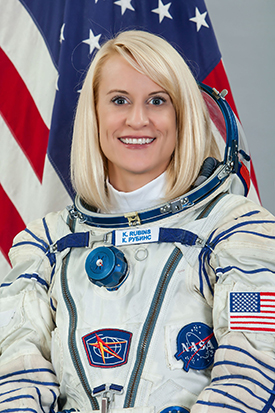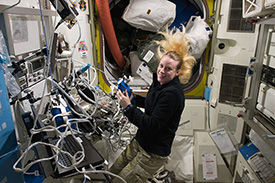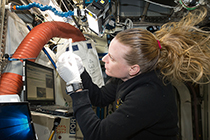Science In Space!
Astronaut Kate Rubins Visits NIH

PHOTO CREDIT: NASA
NASA astronaut Kate Rubins.
Scientists usually do experiments in controlled environments, with unlimited access to electricity, air, and gravity. Then there are other scientists who find ways to do research in extreme conditions where everything is compact, suspended, and unknown. Kate Rubins, a molecular biologist turned NASA astronaut, knows how to work in controlled as well as extreme environments—from the remote regions of central Africa to the even more remote regions of outer space. On April 25, 2017 (National DNA Day), she visited NIH to talk about her experiences on Expeditions 48 and 49 to the International Space Station (ISS) and participate in a question-and-answer session with NIH Director Francis Collins.
During her 115 days in space (July–October 2016), Rubins performed two space walks and conducted more than 275 experiments. She was the first person to sequence DNA in the microgravity of space.
Rubins has a Ph.D. in cancer biology from Stanford University School of Medicine (Stanford, California), was a fellow and principal investigator at the Whitehead Institute for Biomedical Research (Cambridge, Massachusetts), and has conducted research on poxviruses and host-pathogen interactions as well as viral mechanisms for regulating host-cell messenger-RNA transcription, translation, and decay. Long before she went to the ISS, she had her first experience working in extreme conditions when she and colleagues were studying an outbreak of monkeypox at a remote site in the Democratic Republic of the Congo.
Rubins is now the Deputy Director of Human Health and Performance at NASA’s Johnson Space Center (Houston, Texas), but she is still a flight-eligible astronaut and could go back to space at any time.
During her NIH visit, she showed a video of herself—blonde hair floating wildly—in space doing experiments and even using a cordless power drill as a centrifuge. The science was punctuated with breathtaking images of Earth taken from space (NASA collects the images to study weather patterns). Collins and Rubins then sat on stage for a conversation with questions submitted by NIH employees as well as by online viewers who were participating in a chat on NIH’s Facebook page. The following has been lightly edited for clarity.
COLLINS: One application for being able to sequence DNA in space might be to survey the health of the astronauts. For example, if you could measure RNA expression in peripheral blood cells of somebody who’s not feeling well, we could then say if it’s a viral or bacterial infection. How far along do you think we are with that?
RUBINS: We can draw blood on board, we can make peripheral-blood mononuclear cells (PBMCs), and we can take serum and plasma. So it would be technically feasible to take human-physiology samples, not necessarily just to diagnose disease but to also watch processes like bone loss, fluid changes, and cardiovascular effects. We could look for how the biomarkers of those processes evolve over time.

PHOTO BY NASA
Better Breathing in Space and Back on Earth: Airway Monitoring, an investigation from ESA (the European Space Agency), uses the U.S. airlock as a hypobaric facility for performing science. Utilizing the U.S. airlock allows unique opportunities for the study of gravity, ambient pressure interactions, and their effect on the human body. This investigation studies the occurrence and indicators of airway inflammation in crew members, using ultra-sensitive gas analyzers to evaluate exhaled air. This could not only help in spaceflight diagnostics, but that also hold applications on earth within diagnostics of similar conditions, for example monitoring of asthma.
COLLINS: What about the health implications of long-term weightlessness such as if we send humans to Mars? What would you want to offer to keep the negative effects from being too severe?
RUBINS: We have a number of things that we think about in terms of risks to astronaut health for long-duration space flight. High among those is the radiation environment. We can protect astronauts from radiation exposure either through shielding of the spacecraft or by giving them a countermeasure such as a radioprotective pill. We also need to work on bone and muscle health, the neurovestibular effects of the microgravity environment, and nutrition. We have the technology to be able to figure out how to keep people safe. So there’s no big showstoppers that are absolutely going to prevent us from going to Mars.
COLLINS: Do you think it’s possible that there are going to be identifiable genetic differences between individuals that are predictive of how well they will do in space? If so, will this play some role in astronaut selection?
RUBINS: Certainly, as precision medicine improves our understanding of human health, we’re going to start using this to understand what would be protective from radiation. We’ve got some early results from studies about nutrition and DNA health and how that might be influencing factors in space flight. I think we’ll continue to look at [individual differences] and try to understand how we can select the best performers in this environment.
COLLINS: How did you end up being an astronaut? You got a Ph.D. in molecular biology, skipped the postdoc, became a Whitehead Fellow, and then ended up in the Space Station. I’ve heard of nonlinear careers but this is ridiculous.
RUBINS: I have NIH to thank for why I became an astronaut. I was writing an R01 [grant application] when my friend called me and said, “There are astronaut applications online.” Applying turned out to be an excellent procrastination tool for my grant writing. I never expected to be selected to be an astronaut.

PHOTO BY NASA
The Sequencing of DNA in Space: When Rubins’ expedition began, DNA had never been sequenced in space. Within just a few weeks, she and the Biomolecule Sequencer team had sequenced their one billionth “base” – the unit of DNA - aboard the orbiting laboratory. The Biomolecule Sequencer investigation seeks to demonstrate that DNA sequencing in microgravity is possible, and adds to the suite of genomics capabilities aboard the space station.
COLLINS: What would it take for students to get engaged in these kinds of scientific adventures? Do you have any advice?
RUBINS: I would encourage them to start experimenting early. There’s reading science in the textbook, and there’s a completely different side of science when you have high schoolers running a gel and they can actually see strands of DNA. [Gel electrophoresis is a technique for separating charged molecules like DNA, according to size.] There are excellent educational materials if you go to NASA.gov and look at the “Education” tab. There are experiments that people can do in their classrooms; there are materials for folks who are interested in learning about space. Having that thrill of discovery, you can use your powers of observation to answer some important questions about the world around you.
You can view Rubins’s April 25 talk, which took place in Masur Auditorium (Building 10), at https://videocast.nih.gov/launch.asp?23239 (NIH and HHS only). In addition, you can read about Rubins’s October 2016 space chat with Francis Collins . Check out Kate Rubins’ Space Station Science Scrapbook, too. Read about how NIH and NASA have collaborated over the years.
This page was last updated on Monday, April 11, 2022
